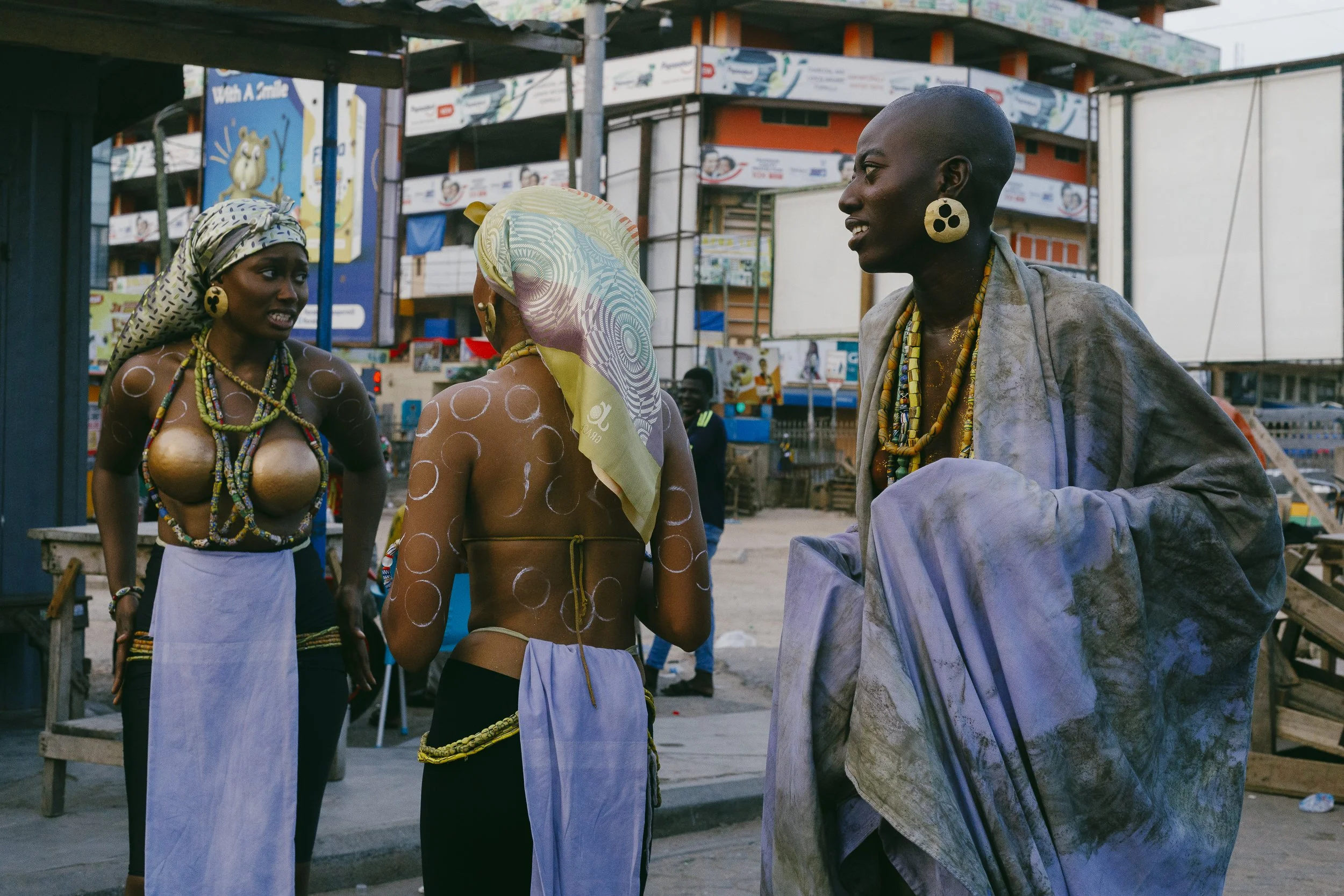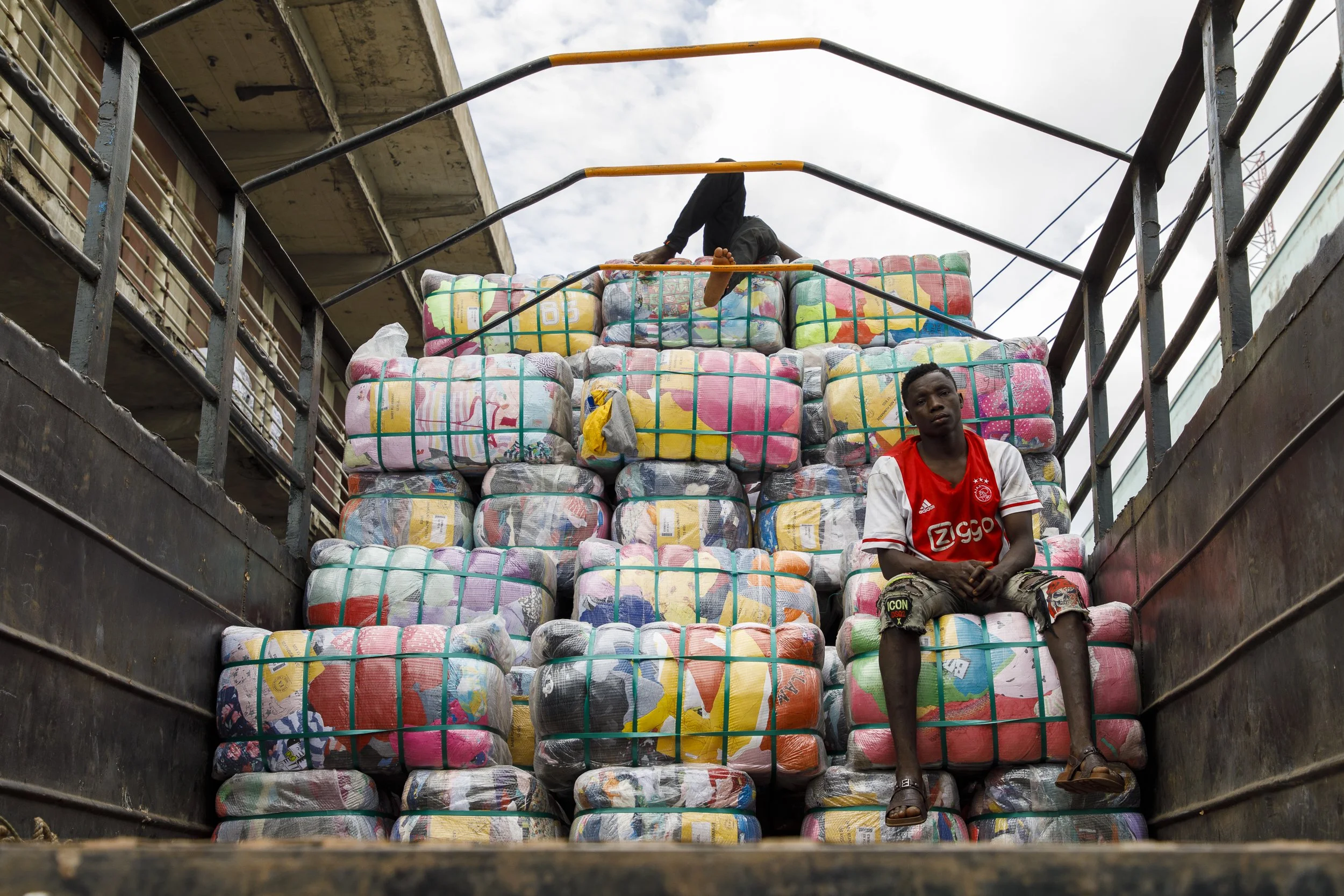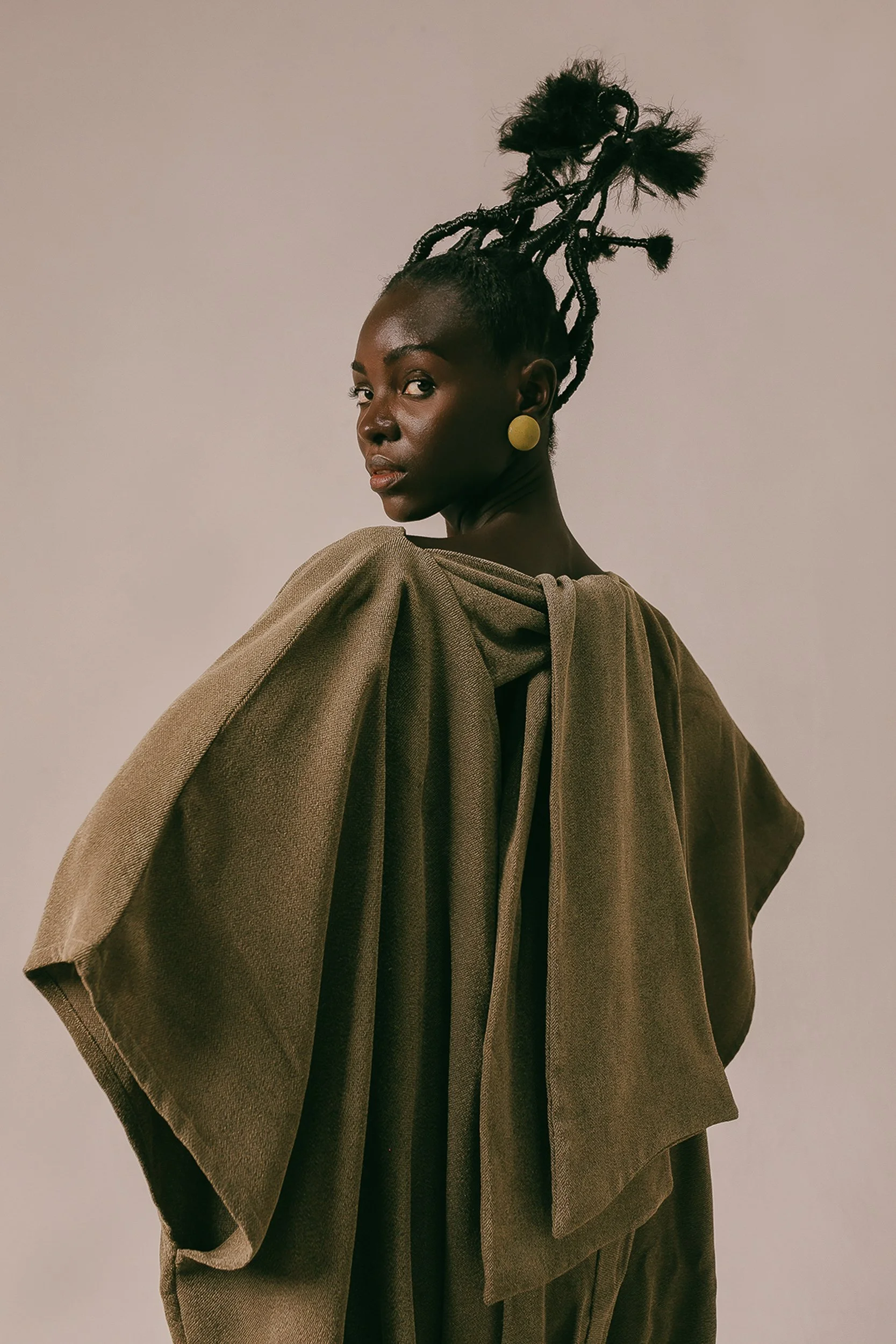Where Visual Storytelling Meets Sustainable Fashion: Inside Tonia-Marie Parker’s Work with The Or Foundation
Backstage of the runway at Obroni Wawu, photographed by Tonia-Marie Parker
My name is Mary Raftopoulos, and I am a reformed shopaholic. There was a time when my wardrobe was less of a collection and more of a fast-fashion landfill in disguise. As a kid, I thought nothing of buying the same pair of shoes in every colour, like I was collecting Pokémon, except my catchphrase was “gotta wear ‘em all… once.” I would also use Primark like a disposable clothing store. Wear it, bin it, repeat.
But growing older has a funny way of shifting your perspective. The more I learned about the realities behind my shopping habits - the waste, the exploitation, the sheer environmental cost, the harder it became to ignore. Slowly, the thrill of a quick purchase was replaced by a different kind of satisfaction of finding interesting pieces that outlived fleeting trends.
Sustainable Reflections, photographed by Tonia-Marie Parker
Now, I’m on a journey not just to change my habits, but to explore how we, as consumers, can rewrite the story of fashion. One person who has dived into the transcultural narratives of fashion waste is the visual artist and photographer Tonia-Marie Parker. Tonia uses fashion as a lens to explore identity, resistance, and the stories our clothes carry. Her lens also captures the complex story of Ghana’s second-hand clothing industry and its ripple effects on society, a project shaped in partnership with The Or Foundation.
The Or Foundation are working hard to re-imagine what the fashion industry could be by addressing one of fashions biggest and least glamorous secrets - the global waste crisis. In short, they’re giving fashion a much-needed wardrobe makeover and this time, sustainability is in season.
MR: You describe yourself as a visual storyteller. How did photography become your medium for exploring identity and resistance?
TM: I didn’t always see myself as a storyteller, even when I began identifying as a photographer. Storytelling revealed itself to me through practice, and as I spent more time behind the camera, I realised photography was more than visual expression; it was a way of holding emotion, memory, and perspective. I chose photography because of its ability to capture a moment in space and time with both immediacy and ambiguity. It offers a visual language that isn’t confined to a single truth but instead opens up space for multiple interpretations. While I initially focused on telling the stories of others, I’ve come to understand that every story I’m drawn to carries something of my own, a resonance I can’t ignore.
MR: Your background is in psychology. How has that shaped the way you approach your subjects and tell their stories through imagery?
TM: My academic background in Philosophy and Psychology has shaped the way I see and relate to people. Studying the human condition from both a theoretical and emotional lens gave me language for things I had always felt but couldn’t yet articulate. It taught me to pay attention to what’s said and unsaid, to how people carry themselves, to what might be behind a moment of stillness or expression. This understanding grounds my approach to photography. It reminds me that every subject is layered, every story has context, and that care is just as important as composition. Storytelling through imagery has become, for me, a way to visualise and appreciate the complexity, dignity, and vulnerability of being human.
MR: What does it mean for you to work at the intersection of art, climate, and culture in Accra, a city that sits at the heart of so many global fashion conversations?
TM: Working at the intersection of art, climate, and culture in Accra means holding both responsibility and possibility. Much of my work centres around Ghana’s Kantamanto Market in Accra, the largest secondhand market in the world and a leading hub for reuse, repair, upcycling, and remanufacturing. It receives 15 million items of secondhand clothing each week, and nearly half (40%) leaves as waste. The market is a sprawling, layered ecosystem. It is fast-moving, crowded, and deeply human. Behind every bale of clothes are kayayei (head porters), retailers, tailors, dyers, resellers, and upcyclers, most of whom form a resilient informal economy. But Kantamanto is also a place of tension. For every opportunity it offers, there’s an environmental or social cost: clothing that cannot be resold or reused becomes waste, clogging drainage systems and overwhelming waste sites. In places like Kantamanto, where the impact of global fashion is felt daily, storytelling becomes a necessary act. It’s not just about documenting harm, but about revealing the ingenuity, resistance, and creativity that exist alongside it. Accra is often spoken about from the skewed outsider lens, but living and working here gives me the chance to tell more honest, layered stories that show not just what’s been discarded, but what’s being reimagined. There is beauty in the ruins, and I see my role as a documentarian as one of care: to represent the complexity of this city with dignity, truth, and vision.
Bales and the bale keeper, photographed by Tonia-Marie Parker
MR: Fashion is often seen as either glamorous or wasteful, rarely both. How do you capture the complexity of fashion’s second life in Ghana?
TM: When photographing secondhand fashion, I look for signs of creative innovation and personal nuance because I’m interested in the people behind the transformations just as much as the fashion itself. My aim is to disrupt conventional ideas of what is considered waste and what is seen as glamorous. Within Kantamanto’s ecosystem, artists and creatives skillfully repurpose textiles marked by stains, tears, or sheer excess, turning them into expressions of style, passion, and cultural commentary. By revealing this process, from discarded garment to reimagined piece, I hope to shift how people perceive fashion’s second life, and with it, how they understand labour, value, and beauty.
MR: Your work explores Ghana’s second-hand clothing industry. What truths have emerged through your lens that aren’t often told in global media?
TM: I wouldn’t say truths have emerged solely through my lens, but there has been growing visibility through my ongoing work and storytelling through The Or Foundation. One of the biggest misconceptions about Ghana’s secondhand clothing industry is that it’s purely a charitable system, a one-way act of giving. But the reality is that the volume of clothing arriving here is overwhelming. What’s framed as generosity often becomes a burden, with excess garments piling up in landfills, drainage systems, and even along the coastline. This overflow is a direct result of the fast fashion industry’s overproduction, disposability, and the false promise of endless textile consumption. These clothes are not just donations but waste in disguise. And while there’s creativity and resilience within this system, it’s also important to expose the imbalance and harm that comes with it.
MR: There’s a haunting beauty to some of your images. How do you strike a balance between aesthetics and advocacy when documenting fashion waste?
TM: I’ve found that I photograph only when it feels right; when the moment resonates with me and reflects my perspective of the subject, and I think that resonance is what guides the balance between aesthetics and advocacy. Beauty, for me, isn’t about glamorising; it’s about drawing people in and making it possible for them to confront hard truths without turning away. A striking image can hold someone’s attention long enough to carry emotion, context, and meaning. As I grow into the craft of photography, I constantly ask myself whether I’m honouring the integrity and reality of my subject, not just when I press the shutter, but even in the moment I consider doing so.
MR: Climate storytelling can feel distant or data-heavy. How do you make these issues personal and immediate through your photography?
TM: When telling stories through my camera, I focus on my subjects and their lived experiences, using the intimacy of everyday details to humanise their struggles. I pay attention to gestures, routines, and the quiet moments in between, the kinds of things that reveal dignity and resilience. My interest in Ghana’s fashion scene pushes me to look for beauty within the struggle, not to mask the hardship, but to create empathy. I want people to feel connected, to see themselves in the images, and through that, be moved to reflect, care, and take action.
MR: In what ways do you see the fashion waste crisis intersecting with histories of colonialism and cultural erasure?
TM: The roots of the secondhand clothing trade in Ghana trace back to colonial times, when the British influence shaped our economy and trade patterns, often at the expense of local industry. Today, that system continues under a different name: now it’s called “donation” or “charity,” but it functions as a way for the Global North to offload its textile waste onto countries like mine. This crisis doesn’t just impact the environment; it also intersects with cultural expression. While Ghanaian identity remains strong, our dressing practices have shifted. It’s now far more common to see young people in jeans and T-shirts than in garments sewn from traditional wax prints. We need more people around the world to understand what waste colonialism is and the impact it has on the affected ecosystems and communities. Our team at The Or Foundation runs an active campaign called Speak Volumes to help call attention to this issue and encourage fashion brands to be more transparent about their production volumes. The data gathered through this campaign is to allow for accurate statistics for the size of the fashion industry, as well as an avenue for clear conversations on textile waste management.
Kezia Agyeman Boafo for Ajabeng, photographed by Tonia-Marie Parker
MR: You often focus on African women. How do their stories shape your broader message around climate justice and cultural resilience?
TM: African women are often at the frontlines of both environmental and cultural labour, not by choice, but by necessity. In documenting their stories, I aim to show how they hold systems together, often with limited resources and invisible recognition. Their strength, creativity, and ability to adapt in the face of environmental and economic pressure embody what climate justice should be about: equity, dignity, and visibility. By focusing on their experiences, I’m able to humanise climate issues and push back against narratives that erase the contributions and knowledge of African women. Their resilience shapes the visual language of my work and reminds me that cultural survival is an act of resistance, one that deserves to be seen and remembered.
MR: Can you walk us through a recent project with The Or Foundation that pushed your practice or perspective in a new direction?
TM: My ongoing project documenting the women in the Mabilgu Transformation Program, all former head porters in the Kantamanto Market, has deeply shifted my practice. The Mabilgu Transformation Program is a holistic initiative focused on empowering young women in Ghana who work as "Kayayei" (headporters). These women, who once served as the literal vehicles of the secondhand clothing trade, transporting by head carrying 55kg of weight per bale, are often the most overlooked and silenced stakeholders. They are not fairly compensated and are often not even considered part of the market society. The program offers these women apprenticeships, financial support, training in financial literacy and health, and opportunities for personal development. I have been constantly reminded that storytelling is an art form and a responsibility I wholeheartedly accept because being able to document their transition, their reclamation of space and self-worth, reminds me that photography can be a tool for amplifying voices too often ignored.
MR: How do you imagine your work evolving as the global conversation around fashion and waste deepens?
TM: As the global conversation around fashion and waste deepens, I see myself evolving with it, leaning more intentionally into advocacy and education, while still honouring my artistic expression. I’m increasingly drawn to exploring other mediums, such as writing and film, to broaden the ways I tell stories and make these issues feel close and urgent. From my corner of the world, I hope to contribute meaningfully to conversations that lead to policy changes, ones that recognise and support the creative ingenuity and resilience of communities in the Global South, who are doing the difficult work of managing the Global North’s waste.
MR: What would a truly just and regenerative fashion future look like to you, and what might it feel like through a photograph??
TM: A truly just and regenerative fashion future, to me, is one where the burden of waste is no longer shouldered by the same people who have always carried it physically, emotionally, and economically. It’s a future where the Global South is not treated as the endpoint of fashion, but is appreciated and acknowledged as a centre of innovation, creativity, and leadership. The photograph of a just and regenerative fashion future feels warm and alive. The light, filtered and soft, reveals the vibrancy of Accra. People move with a sense of dignity, shared purpose, deep care and pride in their eyes because the secondhand clothing industry and trade is no longer a burden on the people and the environment but a source of creative power and resistance.







My name is Mary Raftopoulos, and I am a reformed shopaholic. There was a time when my wardrobe was less of a collection and more of a fast-fashion landfill in disguise. As a kid, I thought nothing of buying the same pair of shoes in every colour, like I was collecting Pokémon, except my catchphrase was “gotta wear ‘em all… once.” I would also use Primark like a disposable clothing store. Wear it, bin it, repeat.
But growing older has a funny way of shifting your perspective. The more I learned about the realities behind my shopping habits - the waste, the exploitation, the sheer environmental cost, the harder it became to ignore. Slowly, the thrill of a quick purchase was replaced by a different kind of satisfaction of finding interesting pieces that outlived fleeting trends.